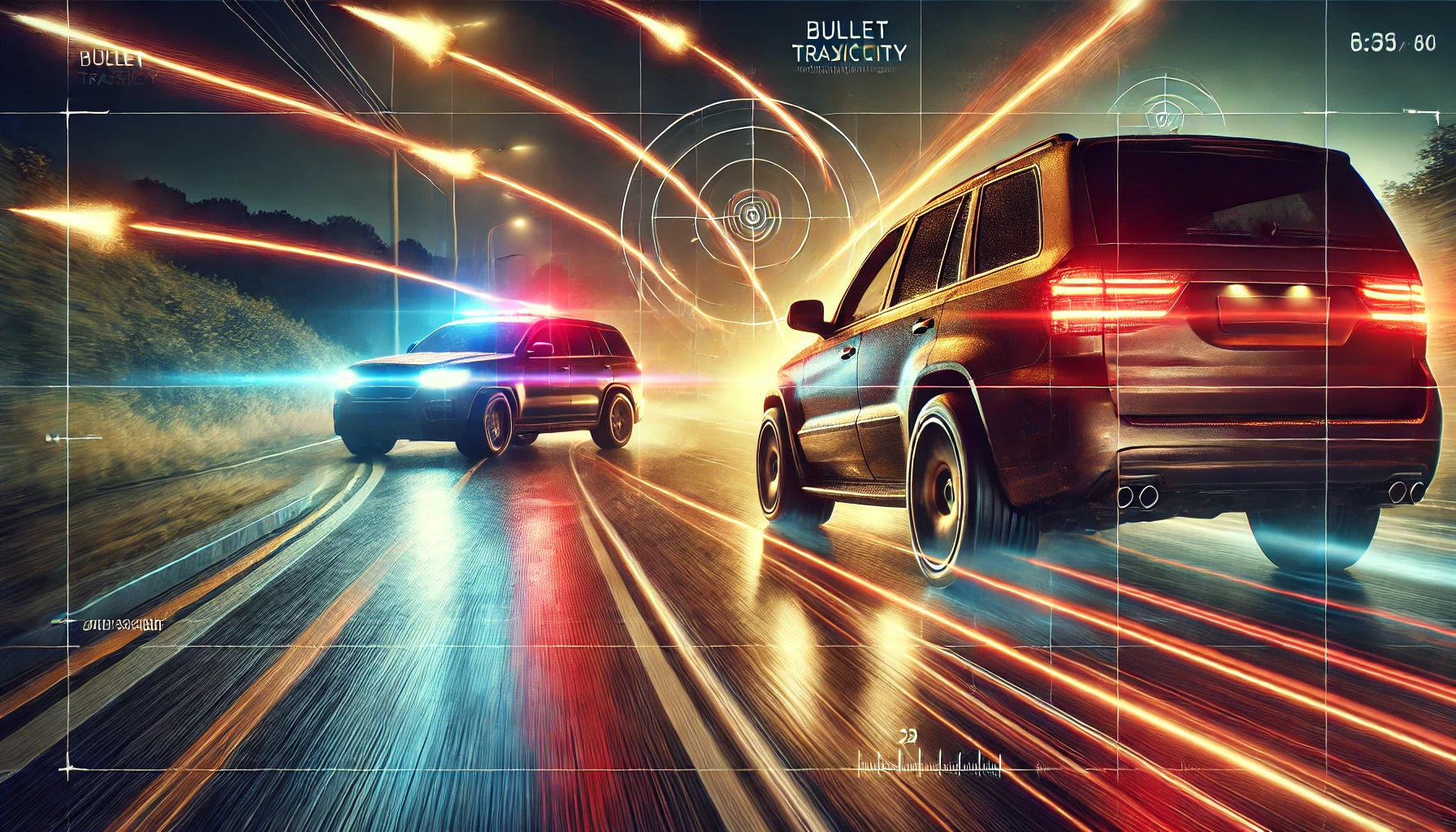Ballistics at 70 MPH: A Forensic Nightmare in Motion
The cinematic image of bullets flying between speeding vehicles at 70 miles per hour is gripping—but reality doesn’t obey Hollywood physics. In real-world law enforcement and forensic ballistics, such a scenario is a minefield of misunderstood science, flawed conclusions, and tragically wrong legal outcomes.
This article breaks down the physics, ballistics, and investigatory challenges of a gunfight between two vehicles traveling in the same direction at high speeds—analyzed through the lens of real-world tactical understanding and technical precision.
Understanding the Battlefield: Relative Motion at Speed
In a same-direction engagement where both vehicles are moving at 70 mph, their relative speed to each other is zero—but only in the longitudinal axis. In reality, road grade, lane shifts, acceleration, and deceleration create dynamic variables. This means:
- Shot alignment is constantly disrupted by subtle changes in vehicle motion.
- Any braking or acceleration causes immediate shift in shot angle and lead.
- Even small lateral movements (like a drift in the lane) affect bullet trajectory relative to the target.
Shooters in such scenarios are dealing with a moving platform, trying to hit a target that is also unstable, while both are being buffeted by wind resistance and terrain vibrations.
The Ballistics Breakdown: What Happens to the Bullet
Once a round leaves the muzzle, external ballistics take over—and these are significantly altered by the vehicle’s motion:
- Forward shots gain velocity from the vehicle’s speed:
A 9mm round (~1,200 ft/s) fired forward becomes effectively 1,302.7 ft/s. - Rearward shots lose velocity, as the bullet’s speed is reduced by the vehicle’s motion.
- Lateral shots are influenced by the vehicle’s forward momentum, causing curved trajectories.
These variables shift the point of impact considerably, especially when the shooter fails to account for wind drag, yaw, and bullet destabilization upon exit from a confined vehicle space.
Gyroscopic Drift and Angular Deflection: The Invisible Killers of Accuracy
Although gyroscopic drift is minimal in short-range engagements, at highway speeds, even slight deviations are magnified. Combined with the shifting “angle of departure” caused by a moving shooter and target, the angle of attack becomes almost impossible to standardize. The shooter must:
- Apply offsets to account for forward motion.
- Estimate lead dynamically as both vehicles maneuver.
This makes precision shooting highly improbable, even for elite shooters.
Platform Instability: Shooting from a 4-Wheel Earthquake
Whether shooting through a window or over a dashboard, the vehicle is a terrible shooting platform. Oscillations in suspension, vibration from the engine, and the shooter’s body being jostled make sight picture retention nearly impossible.
Even the most trained operators will struggle. In real-world terms:
- Point shooting becomes the default, as using sights is rarely viable.
- Suppressive fire is often more logical than attempting precision.
How Experts Get It Wrong: Misinterpretation by Police and Ballistics Analysts
Police reports and court testimonies often lack nuance when it comes to dynamic shooting conditions. Here’s how forensic experts and investigators can misread the scene:
1. Trajectory Assumptions Based on Static Models
Most ballistic reconstructions are done assuming static positions—ignoring vehicle movement and dynamic engagement variables. This leads to erroneous conclusions about shooter intent, angles, and even legality.
2. Impact Points Misread as Aimed Shots
Investigators often assume that a shot which hits the rear quarter panel was “aimed” there—when in reality, it’s the result of drift, instability, and trajectory curve, not target selection.
3. Misplaced Confidence in Entry/Exit Wound Analysis
Autopsy reports might claim an “upward trajectory” without considering that the victim’s torso was reclined or thrown forward by sudden braking, or that the shooter was in a vehicle in motion.
Practical Reality: Why These Shots Are So Hard to Make
Engaging another moving vehicle at 70 mph in the same direction is one of the most difficult real-world shooting scenarios. Here’s why:
- Extremely limited target exposure due to vehicle structure.
- Vibration-induced movement makes any precise sight alignment fleeting.
- Real-time ballistic calculation by the shooter is impractical.
- Glass and steel deflection cause yaw, fragmentation, or complete deviation from intended path.
- Adrenaline and stress reduce fine motor control, visual focus, and decision-making clarity.
These factors combine to make hit probability extremely low and unintended consequences—such as collateral damage or missed shots—very high.
Conclusion: Why Context is Everything
In evaluating shootings between moving vehicles, especially those going in the same direction at highway speeds, contextual ballistics must be the foundation of any analysis. Simplified reconstructions, linear trajectory diagrams, or assumptions of shooter intent based on static models are not only misleading—they are dangerous in the judicial process.
Law enforcement training, expert testimony, and public perception must evolve to reflect this reality: Dynamic shooting at speed is chaos, not calculus. Unless the shooter is highly trained in mobile interdiction and counter-ambush tactics, any successful hit is likely a combination of proximity, chance, and high-volume fire—not precision marksmanship.
For in-depth ballistics consultation or tactical training programs in mobile engagements, contact Valortec Training Division. Our curriculum is designed for both law enforcement and private security operators who need to understand not just how to shoot, but when and why it’s physically—and ethically—feasible to do so.






